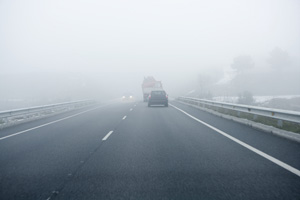Tips for Driving Safely in Fog
Snow. Ice. Rain. When you think of weather conditions that make it difficult to drive, these are probably the first ones that come to mind. One weather hazard you shouldn’t underestimate, however, is fog. It is unpredictable, often unexpected and can contribute to accidents when drivers don’t adjust to the conditions. That was the case earlier this year when five trucks were involved in a pileup on a foggy highway in Canada. Understanding when and why fog occurs and tips for driving in it can help prevent you from ending up in a similar situation.

Increase your following distance immediately upon entering a foggy area. The National Weather Service equates fog to a cloud on the ground. It forms when the temperature drops to the dew point and water vapor in the air condenses to form water droplets. The closer the actual temperature gets to the dew point, the more likely fog is to occur. Early morning and late evening are prime times for fog because the temperature is typically cooler. Before starting your route, check the weather forecast and pay close attention to the dew point and how the actual temperature compares to it.
Fog is especially dangerous for drivers because it throws off perception. When driving, you use motionless objects like roadway signs to help gauge speed and distance, among other things. Fog significantly limits your visibility. This makes it harder to judge your speed or how far away you are from other vehicles.
Drive safely in foggy conditions by following these tips:
- Reduce your speed and increase your following distance immediately upon entering a foggy area.
- Don’t resume full speed until the fog has entirely cleared. There’s no way to know how far the fog extends so remain patient.
- If possible, avoid driving in a pack of other vehicles. Leave plenty of room between you and others on the road.
- Use low-beam headlights and fog lights to help increase visibility. Do not use high-beam lights as they reflect off moisture droplets.
- Turn on your four-way flashers to help other vehicles see you.
- Turn off the cruise control to maintain control of your truck.
- Use pavement markings and reflectors as guides to determine how the road may curve ahead of you.
- Do not pass other vehicles, especially on two-lane highways, and avoid changing lanes or crossing traffic unless absolutely necessary.
- Signal early and brake cautiously. Other drivers need extra time to see and react to your signal.
- Listen for traffic you cannot see. Travel with the driver’s window partially open so you can better hear traffic.
- Do not stop along the side of the road unless it is absolutely necessary. If you have to stop, pull well onto the shoulder and turn on your emergency flashers.
Avoid accidents caused by fog by slowing down, increasing your following distance and adjusting to the conditions.
<< back |
